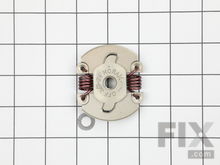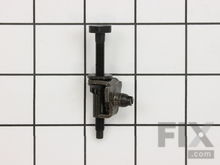How To Repair Pole Saw With A Chain That Will Not Cut
- Rated as REALLY EASY
- 5 step by step videos
Clutch
If your engine runs normally, but the chain does not spin when the throttle is engaged, there may be an issue with the clutch. The clutch is attached to the crankshaft, and engages the chain to start rotating once a certain rotational speed is reached. The clutch allows the engine to run without always rotating the chain. When the engine is revved up, the clutch engages the clutch drum, which rotates the driveshaft that connects to the sprocket and forces the chain to turn. If the clutch is broken or the springs are not tensioned properly, the clutch may not engage at all. A broken clutch is easy to replace once the engine housing has been disassembled to allow for access to the clutch. It is a good idea to remove the spark plug and feed a piece of scrap starter rope into the combustion chamber, as this will stop the piston from moving while the clutch is removed. Refer to your user manual for the proper replacement part number if your clutch is broken.
Chain Tensioner
Your pole saw blade may not rotate if the chain is tensioned too tight. When the pole saw is not being used, the chain should sit on the bar fairly snugly, so that when pulled, it will raise around ¼- ½ an inch off of the bar. A chain that is too tight can cause damage to the crankshaft or other associated parts. Pay attention to changes in temperature, as they will affect the tension of the chain. When the pole saw is in use, the chain heats up, causing it to loosen. When using the pole saw for a long time, stop in 20 or 30 minute intervals to check that the chain tension is correct, and make adjustments if needed.
Guide Bar
The pole saw guide bar keeps the chain in place as it rotates. The bar keeps the chain from wobbling during use, which keeps the chain moving in a perfectly straight rotation, and minimizes damage to the pole saw. If wobbling occurs, there will be damage to the bar and the efficiency of the saw will diminish as the blade will not cut as consistently as it normally would. Refer to your user manual for information on how to maintain both the chain and the bar, and for instructions on how to repair or replace a damaged bar.
Chain
A damaged chain will slow down or stop the pole saw from cutting as efficiently as it usually would. Chains should be inspected and maintained on a regular basis to prevent damage to the machine and possible injury to the operator. If your chain is damaged and getting stuck inside of the bar, or not rotating or cutting properly for other reasons, the chain will likely need to be replaced altogether. Most damage to a pole saw chain occur when the chain is tensioned too loosely allowing it to come free from the bar. When the rapidly rotating chain leaves the bar the drive links are damaged creating burrs on them. If the damage chain is reinstalled on the bar the burrs will bind inside the groove on the bar.
Sprocket
The sprocket is responsible for turning the blade. It attaches to the crankshaft and clutch, and has metal teeth on it to grip the chain and force it to rotate as the crankshaft spins. A worn sprocket may allow the chain to come loose from the bar while in operation, which can be very dangerous. When inspecting the sprocket, look for any signs of cracks or wear to both the teeth, as well as the sprocket housing. If the teeth are worn and cannot grip the chain continuously, or if there are any signs of damage or wear, the sprocket will need to be replaced.
More Repair Parts
Still not sure which part is broken? We can offer you custom troubleshooting help if you search with your model number.



















